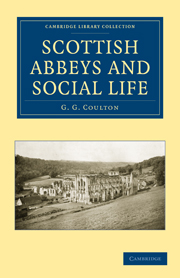Book contents
- Frontmatter
- Contents
- LIST OF ILLUSTRATIONS
- Preface
- Chapter I Celtic Monachism
- Chapter II The Monastic Rules
- Chapter III Monastic Revenues
- Chapter IV How Endowments Came (I)
- Chapter V How Endowments Came (II)
- Chapter VI Monks and Parishes (I)
- Chapter VII Monks and Parishes (II)
- Chapter VIII Charity (I)
- Chapter IX Charity (II)
- Chapter X Monk and Peasant (I)
- Chapter XI Monk and Peasant (II)
- Chapter XII Monastic Housekeeping
- Chapter XIII Church and Scriptorium
- Chapter XIV The Monastic Chronicler
- Chapter XV Schools
- Chapter XVI Art and Learning
- Chapter XVII Professions and Business
- Chapter XVIII Visitation (I)
- Chapter XIX Visitation (II)
- Chapter XX A Voice from the Cloister
- Chapter XXI Conclusion
- Appendixes
- List of Authorities
- Index
Chapter V - How Endowments Came (II)
Published online by Cambridge University Press: 05 August 2011
- Frontmatter
- Contents
- LIST OF ILLUSTRATIONS
- Preface
- Chapter I Celtic Monachism
- Chapter II The Monastic Rules
- Chapter III Monastic Revenues
- Chapter IV How Endowments Came (I)
- Chapter V How Endowments Came (II)
- Chapter VI Monks and Parishes (I)
- Chapter VII Monks and Parishes (II)
- Chapter VIII Charity (I)
- Chapter IX Charity (II)
- Chapter X Monk and Peasant (I)
- Chapter XI Monk and Peasant (II)
- Chapter XII Monastic Housekeeping
- Chapter XIII Church and Scriptorium
- Chapter XIV The Monastic Chronicler
- Chapter XV Schools
- Chapter XVI Art and Learning
- Chapter XVII Professions and Business
- Chapter XVIII Visitation (I)
- Chapter XIX Visitation (II)
- Chapter XX A Voice from the Cloister
- Chapter XXI Conclusion
- Appendixes
- List of Authorities
- Index
Summary
A kindred subject to burials is that of relics. A great medievalist of our day, Luchaire, has written: “The true religion of the Middle Ages, to speak frankly, is the worship of relics”. That is a hard saying; yet it contains a painful proportion of truth. Every altar must have a relic in it, however small; it need not be known what saint the relic comes from; but relic there must be, by Church law. A relic would cure a lifelong cripple, even against his will. Other orthodox theologians of the Middle Ages will be found agreeing with Giraldus Cambrensis, who wrote that the relics handed down from the Celtic Church, in especial, “are in great reverence among both clergy and people in Ireland, Scotland and Wales, so that they are far more afraid to swear false oaths over such relics than over the Gospels”. And Giraldus adds an explanation which has double force from the pen of a really learned and far from uncritical Welshman:“For” (he says) “owing to a certain occult power, seemingly granted them from God, and owing to the vindictiveness to which those saints, above all others, seem prone, those who despise them are oftentimes punished”. Abbot Bower of Inchcolm makes the same boast; the English robbed his abbey in about 1335; but a squall came on, and their boat went down like lead, so that (says Bower) “it became a proverb among the English that St Quhalm [for so they called St Columba] was a great recompenser and avenger of injuries done to himself”.
- Type
- Chapter
- Information
- Scottish Abbeys and Social Life , pp. 68 - 75Publisher: Cambridge University PressPrint publication year: 2010First published in: 1933

